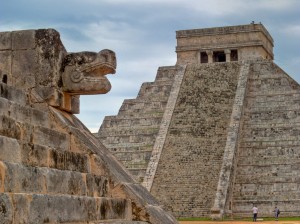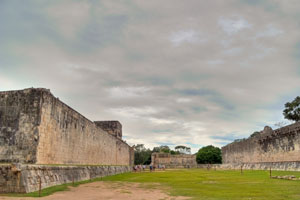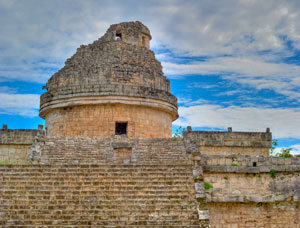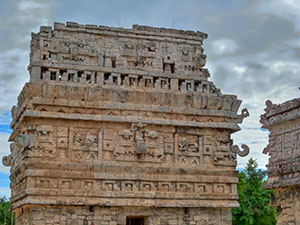 Next on our tour was Chichen Itza, perhaps the most famous Mayan ruin of all. [photo gallery] Most of what we see today is a combination of Terminal Classic Maya and Post-Classic newcomers such as the Toltecs.
Next on our tour was Chichen Itza, perhaps the most famous Mayan ruin of all. [photo gallery] Most of what we see today is a combination of Terminal Classic Maya and Post-Classic newcomers such as the Toltecs.
The site is dominated by the iconic El Castillo Pyramid, which was dedicated to the feathered serpent god Kukulkan. The restored stairway is flanked by gigantic stone serpents. Additional buried sturctures have recently been discovered at its base. The numerological and astronomical aspects of this temple are many, but my favorite is how a sunlit snake appears every equinox. If you clap your hands you will hear an eerie bird call (which our guide claimed was a Quetzal).
 The Temple of the Warriors is a fantastic edifice, with many carved columns. Each carved side depicts a warrior in full regalia with a huge headdress standing on a mystical serpent. Unfortunately I was limited to walking around it so I could not get close to the better parts. <frown> The temple is contiguous with a huge array of circular columns that once supported a roof. One platform is ringed by carvings of eagles and jaguars.
The Temple of the Warriors is a fantastic edifice, with many carved columns. Each carved side depicts a warrior in full regalia with a huge headdress standing on a mystical serpent. Unfortunately I was limited to walking around it so I could not get close to the better parts. <frown> The temple is contiguous with a huge array of circular columns that once supported a roof. One platform is ringed by carvings of eagles and jaguars.
 Mirroring this theme across a broad grassy area in front of the Castillo is the small but elegant Platform of Eagles and Jaguars. It has well-preserved reliefs and snakehead ornamentation on all sides.
Mirroring this theme across a broad grassy area in front of the Castillo is the small but elegant Platform of Eagles and Jaguars. It has well-preserved reliefs and snakehead ornamentation on all sides.
 Behind the temple is a series of low platforms ending in the Tzompantli or Skull Rack. Apparently the skulls of captives and sacrificial victims were displayed here stacked on wooden stakes.
Behind the temple is a series of low platforms ending in the Tzompantli or Skull Rack. Apparently the skulls of captives and sacrificial victims were displayed here stacked on wooden stakes.
 The Platform of Venus sported carvings of men emerging from the mouths of a feathered serpent. The friezes above each of these had whimsical images of tadpoles. There were so many things to see in this area I lost track! Unfortunately it remained cloudy all morning so photography was difficult.
The Platform of Venus sported carvings of men emerging from the mouths of a feathered serpent. The friezes above each of these had whimsical images of tadpoles. There were so many things to see in this area I lost track! Unfortunately it remained cloudy all morning so photography was difficult.
 A wide raised road or Sacbe leads from this area 1000ft to the Sacred Cenote. The road passes through a perimeter wall that once guarded the temple area. This area was lined with local vendors standing shoulder to shoulder in hopes of making a sale. There’s not much to see now, but in its day the Cenote was used to sacrifice to the rain god Chaac.
A wide raised road or Sacbe leads from this area 1000ft to the Sacred Cenote. The road passes through a perimeter wall that once guarded the temple area. This area was lined with local vendors standing shoulder to shoulder in hopes of making a sale. There’s not much to see now, but in its day the Cenote was used to sacrifice to the rain god Chaac.
 The Grand Ball Court is truly enormous, and one wonders whether it was a ritual center rather than a venue for actual competition (the rings are thirty feet high!). On the sidelines are carvings of the players, one of which can be seen holding a knife and a severed head! The small Temple of the Bearded Man is in the north end zone. The Upper Temple of the Jaguar overlooks the southern end.
The Grand Ball Court is truly enormous, and one wonders whether it was a ritual center rather than a venue for actual competition (the rings are thirty feet high!). On the sidelines are carvings of the players, one of which can be seen holding a knife and a severed head! The small Temple of the Bearded Man is in the north end zone. The Upper Temple of the Jaguar overlooks the southern end.
 I’ll conclude with a description of The Observatory and its companions. (It is also known as the Caracol or snail because of its spiral stairs.) This was a functioning astronomical observatory with small apertures aligned to the movements of the Sun, Moon and the planet Venus. (It was very frustrating not to have better access!) It sits on a platform with huge overhanging walls. We also had a great view at night from the hotel bar. (I’m not kidding!)
I’ll conclude with a description of The Observatory and its companions. (It is also known as the Caracol or snail because of its spiral stairs.) This was a functioning astronomical observatory with small apertures aligned to the movements of the Sun, Moon and the planet Venus. (It was very frustrating not to have better access!) It sits on a platform with huge overhanging walls. We also had a great view at night from the hotel bar. (I’m not kidding!)
 Across a small lawn were two small Puuc style buildings with elaborate carvings. One known as The Church had a crown of masks. The other had a seated figure over the door. Beside them were the remains of a ritual bath with walk-in tub!
Across a small lawn were two small Puuc style buildings with elaborate carvings. One known as The Church had a crown of masks. The other had a seated figure over the door. Beside them were the remains of a ritual bath with walk-in tub!
